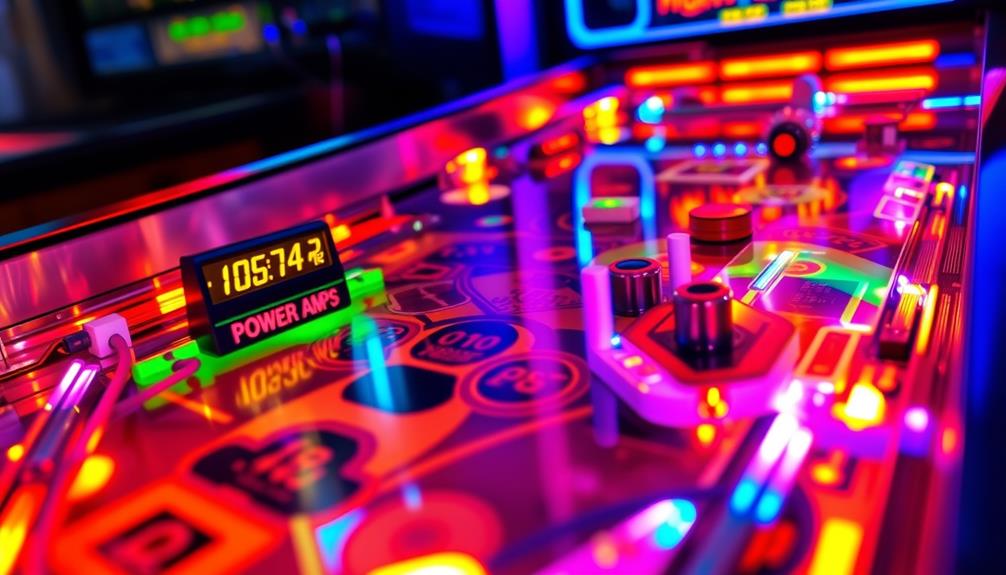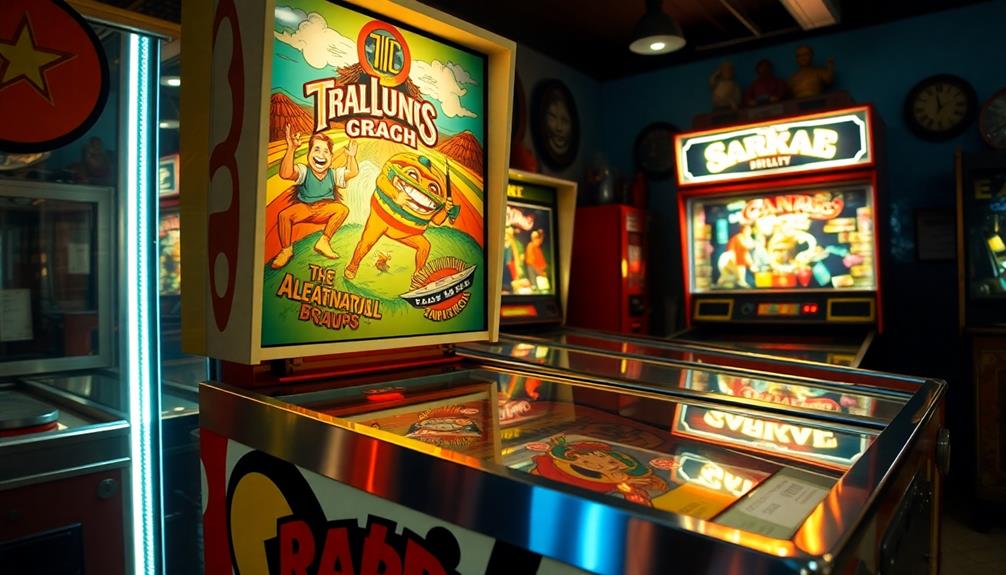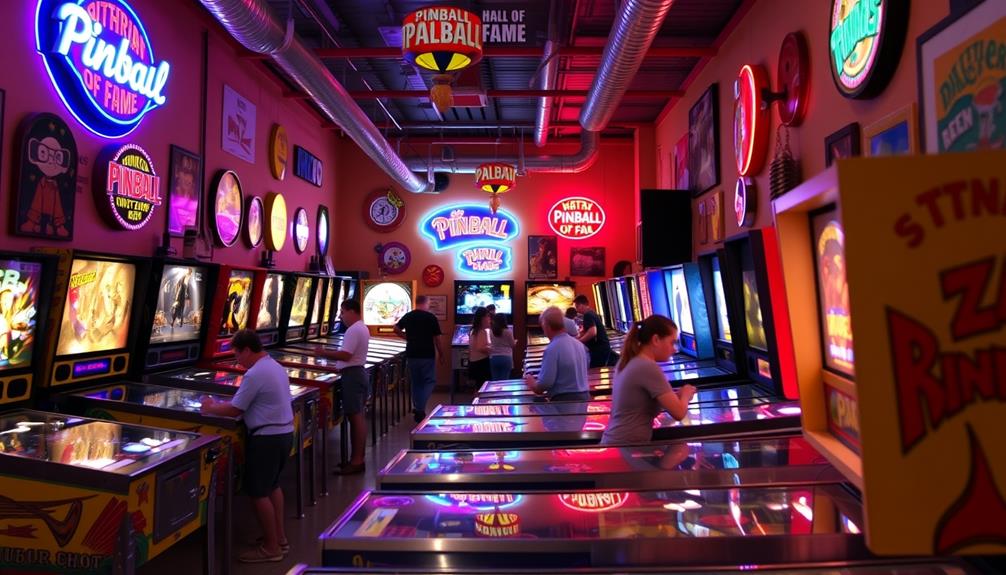A pinball machine generally uses between 1.6 and 2.5 amps while in regular play. When in multiball mode, it can reach a peak of 3 to 5 amps. While idle, it typically consumes around 1 to 1.5 amps, but older machines may need up to 2.5 amps. Keep in mind the initial power surge when starting up, which can briefly spike to 4.5 to 5 amps. To safely operate multiple machines, be sure to follow circuit recommendations and avoid overloading your circuits. By delving deeper, you will uncover effective strategies to manage your pinball machine’s power requirements and ensure a seamless gaming experience.
Key Takeaways
- Standard pinball machines draw between 1.6 and 2.5 amps during regular gameplay.
- Peak amperage can reach 3-4 amps, especially during multiball mode.
- Idle machines consume about 1 to 1.5 amps, with an average of 2 amps.
- Initial startup power surges can briefly reach 4.5 to 5 amps.
- It's recommended to limit to 4-6 machines on a single 20A circuit for safety.
Understanding Pinball Machine Amperage
When it comes to understanding pinball machine amperage, you'll find that most standard machines typically draw between 1.6 and 2.5 amps during regular play. The amp draw can vary based on the specific model and its features, with older machines generally requiring around 2.5 amps. To ensure that you don’t overload your electrical system, it’s important to consider the pinball machine power usage when determining where to place the machine in your home. It’s also worth noting that certain modifications or add-ons, such as lighting or special effects, can increase the amp draw significantly. For this reason, it’s important to consult the manufacturer’s specifications or a professional electrician to ensure that your electrical system can safely support the power usage of your pinball machine.
It's vital to keep in mind that these machines often hold a considerable emotional value, much like heartfelt memories in tributes that celebrate their legacy. When you first power up a machine, expect a brief surge in current, reaching 4.5 to 5 amps, before it stabilizes to its normal operational range.
During active gameplay, especially in modes like multiball, the peak amperage draw can spike to 3-4 amps. This is due to multiple solenoids engaging simultaneously, which can greatly increase the electrical load.
So, when setting up your pinball machines, it's critical to evaluate these amp draw figures to guarantee you don't overload your circuits.
For safety and efficiency, you should operate no more than 4-6 pinball machines on a single 20A circuit, keeping in mind the continuous load rating of 16A. By understanding the amperage requirements of your machines, you can avoid electrical issues and ensure a smooth gaming experience.
Typical Power Consumption Rates
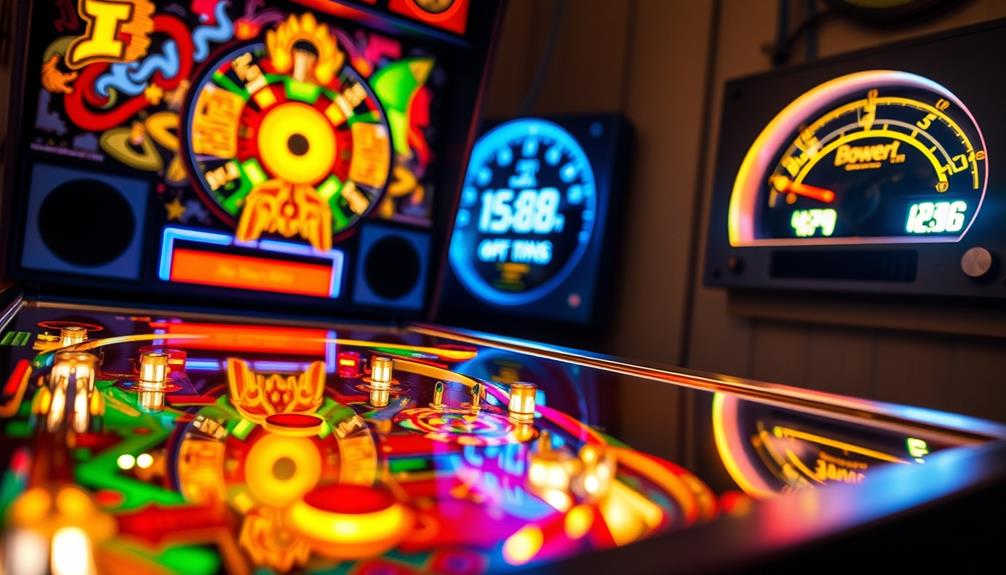
When you look at typical power consumption rates for pinball machines, you'll notice some interesting variations.
Understanding the importance of a well-structured music production workflow can help in managing resources effectively.
The peak draw during intense gameplay can spike considerably, while idle modes require much less power.
Additionally, lighting effects can greatly impact overall consumption, especially in machines with extensive features.
Peak Power Draw
Pinball machines can really ramp up their power draw during gameplay, especially in high-energy moments like multiball mode. When you're fully immersed in the action, it's easy to overlook how much energy these machines consume.
During intense play, peak power draw can soar to 3-4 amps, making your gaming experience electrifying! Understanding the energy demands of devices, such as those found in the best vacuums for dust removal in 2024, can help you appreciate similar power consumption in pinball machines.
Here are some key points about peak power draw in pinball machines:
- Inrush Current: When first powered on, machines can briefly draw 4.5 to 5 amps.
- Older Machines: Electromechanical (EM) models consume more current than modern digital display (DMD) machines.
- Lighting Effects: Extensive lighting in certain models can push the draw over 2.4 amps.
- Average Consumption: Typically, a standard pinball machine operates around 2.5 amps at 120 volts, totaling about 300 watts.
Understanding peak power draw helps you appreciate the energy demands of your favorite pinball machines. Whether you're playing solo or battling friends, knowing how much power is at play adds another layer to your gaming experience!
Idle Consumption Rates
Most idle pinball machines draw about 1 to 1.5 amps, which is significantly lower than their power consumption during intense gameplay.
Interestingly, astrology claims to influence personality traits and attractiveness, which can extend to how we perceive our enjoyment of activities like pinball.
When you first power up a machine, you might notice it spikes to 4.5 to 5 amps briefly, but it quickly settles into its idle consumption rates. This initial surge is why many machines are fused at 5 amps in the primary circuit, ensuring they can handle that momentary increase without any issues.
During actual gameplay, the average power consumption can peak around 2 to 2.5 amps, particularly in multiball mode, where excitement and activity ramp up.
It's important to keep in mind that idle consumption rates can vary between older electromechanical (EM) models and newer digital display (DMD) machines. The features and lighting in these machines can affect overall power draw, leading to different idle rates.
Understanding these idle consumption rates is essential, especially if you're considering energy efficiency or trying to manage your power supply.
With a grasp of these figures, you can confidently enjoy your pinball experience without worrying about excessive power usage.
Lighting Effects Impact
The type of lighting in a pinball machine greatly influences its overall power consumption. When you think about the vibrant lighting effects, remember that different bulbs have different impacts.
For instance, machines with incandescent bulbs can draw considerably more power, especially during exciting gameplay. Additionally, proper maintenance of your pinball machine can enhance its performance and efficiency, much like how essential oils can support essential oils for respiratory health during gameplay.
Here's how lighting effects can affect your experience:
- Attract Mode: Machines can consume around 3 amps to catch your eye!
- Incandescent Bulbs: These can push power draw to about 2.4 amps when multiple lights are activated.
- Multiball Madness: During this thrilling phase, you might see power draw spike to 5 amps due to all the solenoids and lighting effects in play.
- LED Efficiency: Switching to LED can lower consumption, averaging 1.25 to 1.6 amps while still delivering stunning visuals.
Factors Influencing Current Draw
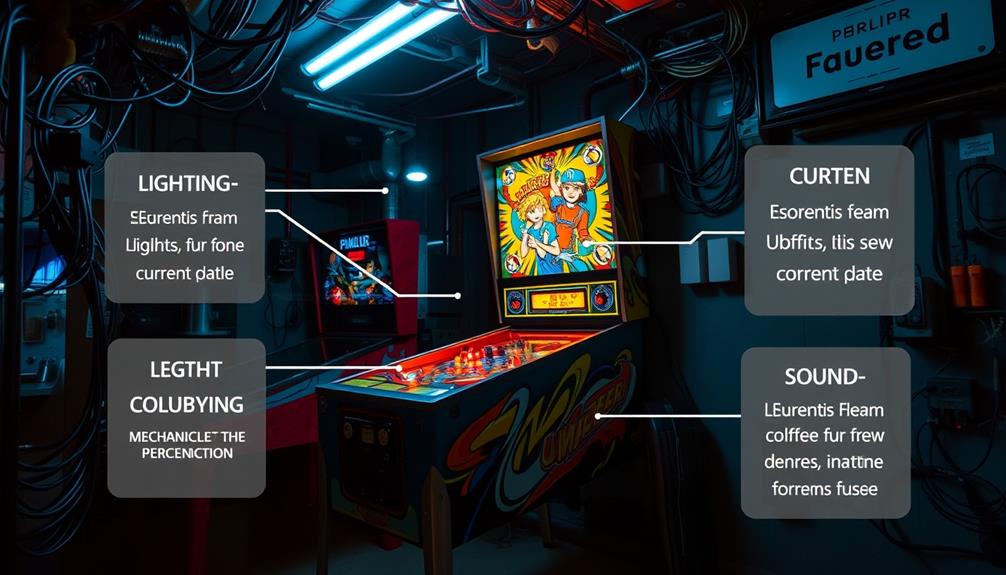
Several factors influence the current draw of a pinball machine, impacting its overall power consumption. When the machine is idle, you can expect a typical draw of around 2 amps. However, during active play, especially in intense modes like multiball, current draw can peak between 2.5 and 4 amps.
Machines with extensive incandescent lighting tend to consume more power compared to those outfitted with LED lighting—some older models may pull up to 2.4 amps. It's also important to take into account the impact of energy-efficient appliances on overall consumption, as this knowledge can help in choosing machines that are more sustainable.
The specific amperage draw varies by machine model and year. Generally, older electromechanical (EM) machines are known to consume more current than their modern digital display (DMD) counterparts.
When you first power up a pinball machine, the initial current draw can surge to approximately 4.5 to 5 amps momentarily before settling down to a more stable average of 1 to 1.5 amps.
Additionally, the total current draw during gameplay is influenced by the activity of solenoids and motors, with an average draw typically recorded at around 2 to 2.5 amps per machine. Understanding these factors helps you gauge your machine's power needs effectively.
Electrical Setup Recommendations
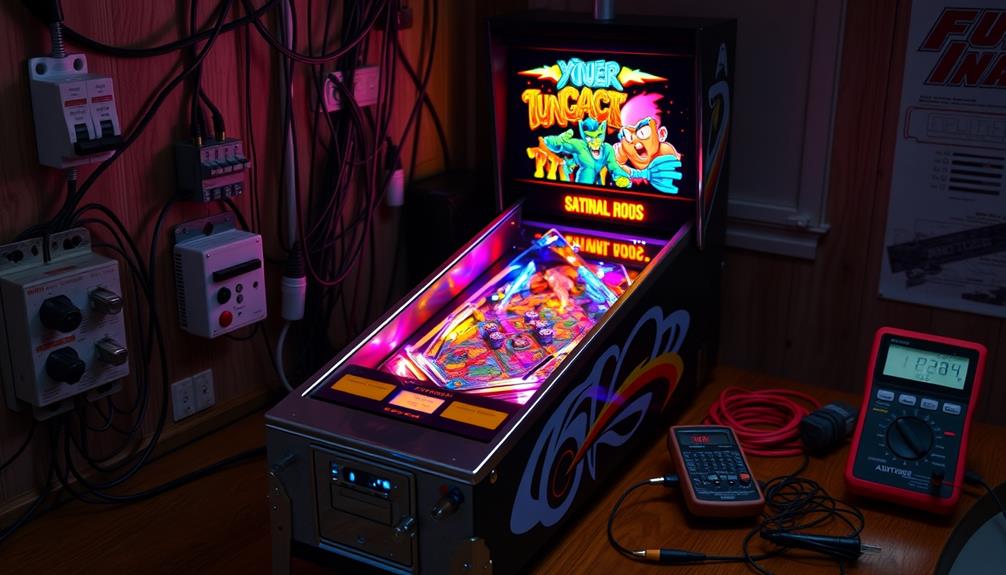
When setting up your pinball machines, it's essential to follow proper circuit configuration guidelines to prevent overloading.
Regular maintenance, such as fuel injection cleaning, can help guarantee that the electrical components remain in good condition.
You'll also want to invest in power monitoring tools to keep an eye on your total amperage draw.
This way, you can ensure a safe and enjoyable gaming experience without tripping breakers.
Circuit Configuration Guidelines
To guarantee safe and efficient operation of your pinball machines, it's crucial to follow proper circuit configuration guidelines. Ignoring these can lead to frustrating power issues or, worse, dangerous situations. Here are some key recommendations to help you set up your circuits:
Additionally, just as home security systems effectively deter potential threats, having the right electrical setup can prevent unexpected outages and keep your machines safe from overloads increased safety and peace of mind.
- Limit Machines: Connect no more than 4 pinball machines to a 15A circuit, or up to 6 on a 20A circuit.
- Monitor Amperage: Confirm the total amperage doesn't exceed 16A on a 20A circuit to prevent tripping the circuit breaker.
- Dedicated Circuits: Whenever possible, use dedicated circuits for each machine. This avoids overloads and keeps your gameplay consistent.
- Consider Age: Remember, older electromechanical models may draw more current than modern digital machines, so adjust your setup accordingly.
Following these guidelines not only enhances your gaming experience but also keeps your machines running smoothly and safely.
Don't take shortcuts; it's worth it to keep the fun going without unexpected interruptions!
Power Monitoring Tools
While setting up your pinball machines, incorporating power monitoring tools can greatly enhance your electrical management. Tools like the Kill-A-Watt provide accurate readings of your machines' power supply, allowing you to understand current draw during both idle and active play.
Here's a quick overview of what you can monitor:
| Monitoring Aspect | Details |
|---|---|
| Idle Mode Amperage | ~2.0 A |
| Active Play Amperage | 2.0 – 2.5 A |
| Multiball Mode Amperage | 4.0 – 5.0 A |
| Breaker Capacity | 16 A (for 20 A circuit) |
| Maintenance Alerts | Spot high consumption |
Regularly checking your machines' power draw helps prevent overload situations by ensuring total amperage stays within the breaker's safe operational capacity. Monitoring energy usage over time also allows you to make informed decisions about circuit load and how many machines you can safely operate. Plus, these tools can highlight machines needing maintenance or upgrades, promoting efficient energy management. By keeping an eye on your power consumption, you can enjoy your pinball machines without worrying about electrical issues.
Safety and Circuit Protection
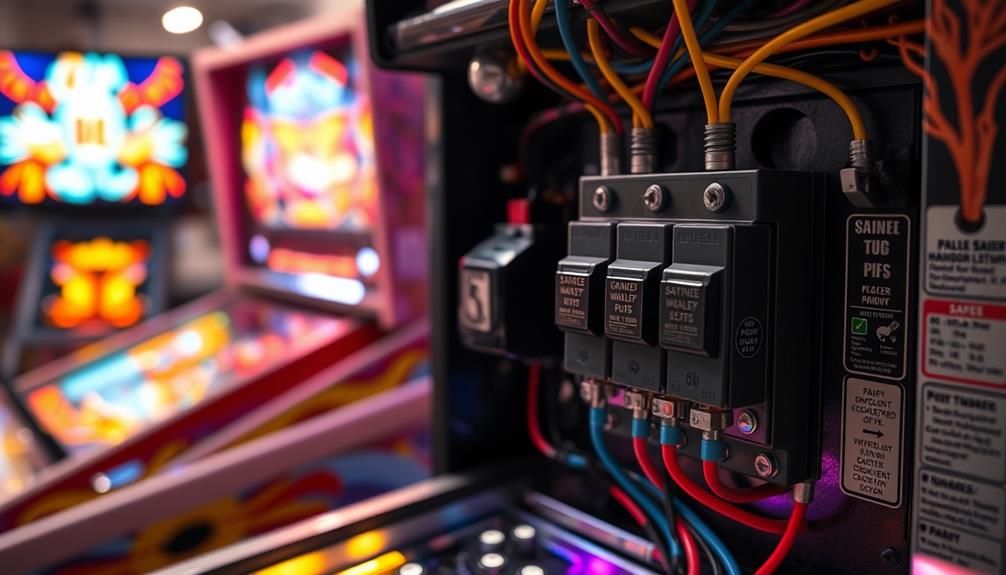
Ensuring safety and circuit protection is essential for anyone setting up a pinball machine. With the potential for a pinball machine to draw 2 to 5 amps, especially during multiball play, you need to take precautions to avoid overloads.
It's crucial to understand the importance of common financial terms when budgeting for setup costs, as well as ongoing maintenance expenses. Here's what you should keep in mind:
- Dedicated Circuits: Install dedicated circuits for each machine to minimize the risk of circuit overload.
- Circuit Monitoring: Regularly monitor your circuit load to catch any overheating issues before they escalate.
- Fuse Ratings: Use appropriate fuses rated lower than the weakest component in the circuit to protect your machine from damage.
- Follow Codes: Adhere to the National Electric Code, which suggests derating circuits to 80% capacity to prevent tripping breakers and potential hazards.
Cost Considerations for Installation

Setting up a pinball machine requires careful consideration of installation costs, especially when you factor in the need for electrical safety and performance. One of the primary cost considerations for installation is whether to hire a union electrician or a handyman.
Union electricians typically charge between $35-$50 per hour, while handyman services can be a more affordable option at $17-$25 per hour. It's also important to confirm that any electrical work is compliant with safety standards to prevent hazards, similar to financial considerations for elderly care where proper planning is essential.
If you're looking to install new circuits, expect the process to take about two hours, which could save you money compared to repairing or replacing pinball machine parts later on. Running new circuits not only enhances the safety of your game room but also reduces the risk of overloads that could damage your machines.
To keep costs manageable, consider consulting local hardware stores for reliable handyman contacts. This can help you secure quality service at a reasonable price.
Additionally, verifying proper circuit installation can prevent frequent breaker trips, saving you from inconvenient and costly issues down the line. By planning ahead and understanding these cost considerations for installation, you can enjoy your pinball setup with fewer worries.
Community Insights and Best Practices
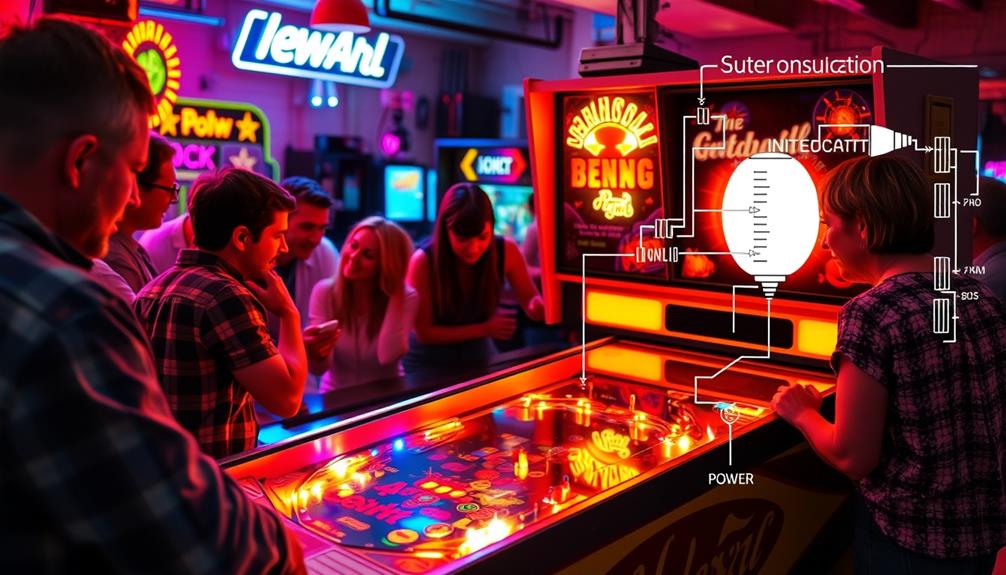
When it comes to powering your pinball machines, community insights reveal valuable best practices to keep everything running smoothly.
Understanding the current requirements of your machines is essential, especially when multiple units are in play. Here are some best practices to take into account:
- Limit Machines Per Circuit: Stick to 4 pinball machines per 20A circuit to prevent tripping breakers.
- Monitor Peak Draws: Be aware that during high-action modes like multiball, your machines can draw up to 4 amps.
- Idle Consumption Awareness: Keep in mind that idle machines consume about 2 amps, which adds up when planning your setup.
- Startup Surges: Remember that at startup, machines may briefly surge to 4.5 to 5 amps, so plan for that in your current calculations.
Frequently Asked Questions
How Many Amps Does a Pinball Use?
When you're setting up a pinball machine, you'll find that it typically draws around 1.6 to 2.5 amps during gameplay. Peak usage can happen, especially in multiball mode, so keep that in mind.
How Many Pinball Machines Are on a 20 Amp Circuit?
You can typically run 5 to 6 pinball machines on a 20 amp circuit. This setup keeps you within safe limits, ensuring smooth operation without overloading the circuit while enjoying your games.
How Many Amps Does an Arcade Machine Use?
Did you know some modern arcade machines draw around 3 amps during play? Typically, they use between 2 to 5 amps, with peak usage hitting 4 to 6 amps during intense gameplay. Keep circuits in mind!
How Many Amps Does a Game System Use?
Most game systems draw around 1 to 2 amps during normal use, but this can vary depending on the model and whether it's running intensive graphics or online features. Check your system's specifications for precise details.
Conclusion
In summary, knowing how many amps your pinball machine draws is essential for a safe and efficient setup. Think of it as the lifeblood of your game, powering everything from the lights to the flippers. By understanding power consumption and considering your electrical setup, you can guarantee a smooth gaming experience. Remember, safety should always be your top priority, so make informed decisions to keep both your machine and your home in top shape. Happy flipping!
